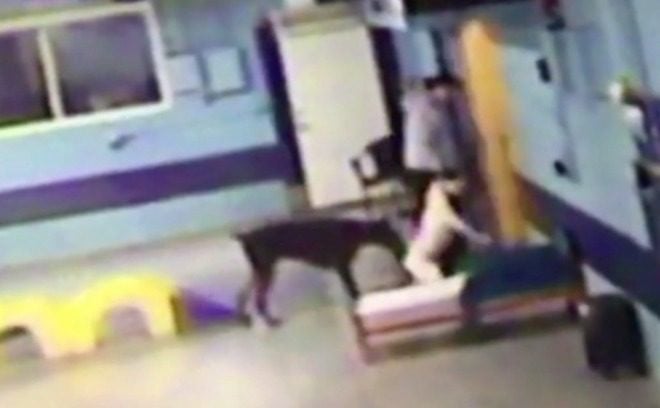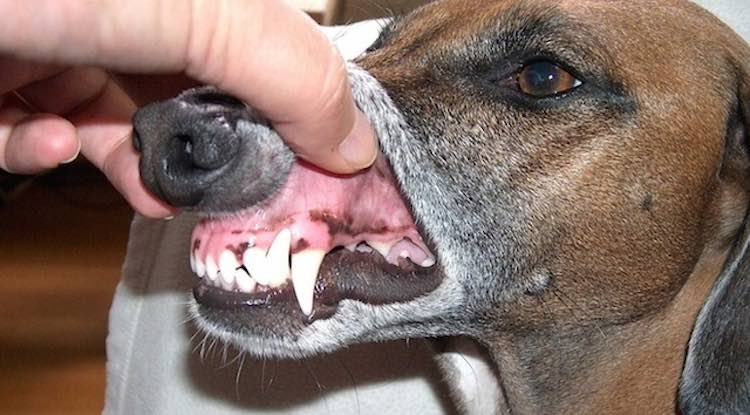How to Help Dogs with Thunderstorm Anxiety (Storm Phobia)
If your dog is anxious during a thunderstorm, he/she is likely suffering from storm phobia. Dogs with thunder anxiety will often display unwanted and destructive behaviors during a storm, and in serious cases, dogs can harm themselves.
This article will provide tips for reducing thunderstorm anxiety in dogs. These tips can also apply to dogs frightened by fireworks.
Behaviorists are not sure what part of the storm frightens dogs most. Some dogs seem to sense a storm before it even happens, perhaps due to the sudden drop in air pressure or the electrical charge in the air. Others react to lightning, wind, and heavy rain and not thunder sounds.
Some breeds may be predisposed to fearing storms. Working and sporting breeds such as Border Collies, German Shepherds, Beagles and Basset Hounds, appear to be more likely to develop a storm phobia than other breeds. This could be because these dogs are genetically bred to react quickly to stimuli. Therefore, storms and loud noises over-stimulate their senses.
Storm phobias are also more likely to develop in shelter and rescue dogs. This may be due to the fact that rescue animals have suffered abuse or trauma in their pasts, or because they may not have been well socialized and exposed early on to a wide variety of sights and sounds.
The absence of early-life experiences and exposures to stimuli can make dogs more anxious and prone to all kinds of phobias.
Symptoms
Physiologically, dogs with storm phobias will have their cortisol levels (stress hormone) increase up to 200% during a storm. This puts a dog into a “flight or fight” state and creates many of the symptoms seen in thunderstorm anxiety.
Symptoms include:
- Restlessness and pacing
- Becoming very clingy
- Trembling
- Whining
- Cowering and tucking the tail
- Dilated pupils
- Drooling
- Hiding
- Trying to escape
In more severe cases, frightened dogs can urinate, chew furniture and shoes, tear up curtains, break windows, and run away from home.
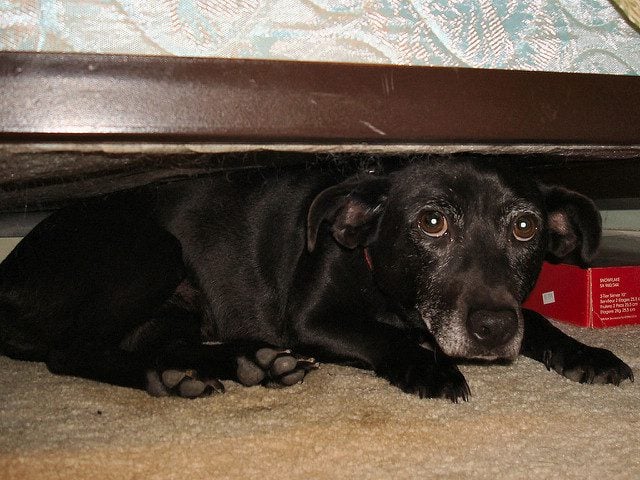
There are few steps to take during a storm that will help calm your dog.
1. Make changes to the home environment.
Bring your dog indoors. Dogs left out doors may panic and try and escape a yard. If panicked they may hurt themselves trying to run indoors, jump over (or through) fencing, or out of a kennel.
Provide a safe hiding place. Make sure your dog has a safe “den” to retreat to, whether this is their regular crate, under your bed, or on favorite blanket.
Preferably, the safe place should be where they regularly go day or night and where they will not be locked in. It is very important a dog does not feel trapped. If a dog goes into a panic he/she can hurt him/herself trying to get out.
Getting dogs used to a crate early on has a tremendous influence on how comfortable they are when things scare them.
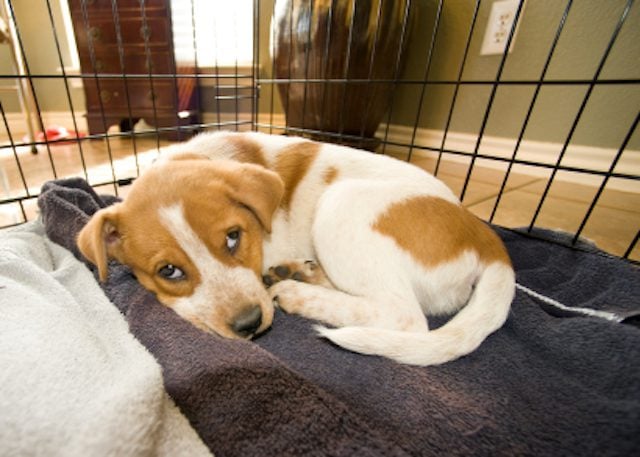

Minimize external noise. During a storm, make sure the dog’s safe place has minimal external noise. Close the windows, blinds or curtains. Play background noise (white noise), such as tuning a radio between stations, putting on soothing music or the television. Avoid noise that has unwanted sounds such as drums, gunfire, fireworks and other startling noises likely to further frighten your dog.
2. Be good role model.
Do not show your dog you are afraid (even if you are). Simply act calm and carry on as normal. If you react, you are indicating to your dog that it is appropriate to be afraid.
3. Avoid being irritated or angry at your dog.
Discipling or yelling at a dog for their anxious behavior will make a storm an even more negative experience for them.
4. Do not overly comfort or cuddle your dog.
This is a controversial topic among behaviorists, as some see “babying” a dog during a storm as rewarding a dog when afraid. But a 2005 study out of Penn State found no difference in cortisol levels (a stress hormone) between storm-phobic dogs whose owners comforted them and those whose owners did not.
The key point is to not teach a dog to become over-reliant on you for comfort. If you are not around, this could lead to an even more anxious dog, as they will not learn how to cope on their own.
To give comfort without creating over-dependence, treat your dog gently and kindly. Let your dog’s behavior guide you. If snuggling up to you for some petting and a few encouraging words helps your dog remain calm and brave in the face of his fears, then offer that emotional support (you can think of it as rewarding the calmness).
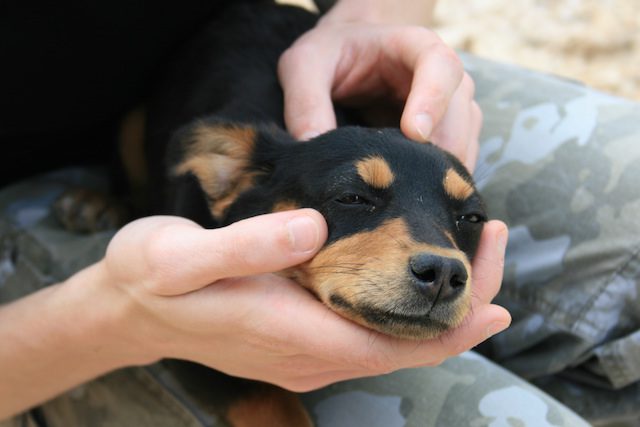

If, however, the added attention seems to make your dog more nervous, then setting a strong silent example may be more appropriate for the dog.
You can also play games with your dog, making it a positive experience (although it’s best to avoid playing noisy games that may end up irritating or agitating your dog). If your dog goes into hiding and comes out to play or grab a bite to eat or drink during a storm, encourage this positive behavior by giving treats and positive encouragement.
5. Work on counter-conditioning through training.
By far the most successful treatment for storm phobia is through counter-conditioning and desensitizing, otherwise known as systematic desensitization. This helps dogs adapt to the noises through training, and gradually teaches a dog to adjust their behavior and not react to storms.
Talk to a veterinarian or dog behavior specialist (trainer) about developing a program for your dog. This form of training is NOT about overexposing your dog to what they are fearful of. Any training or program that encourages flooding or overstimulating a dog to what frightens them, is not appropriate and could further traumatize a dog.
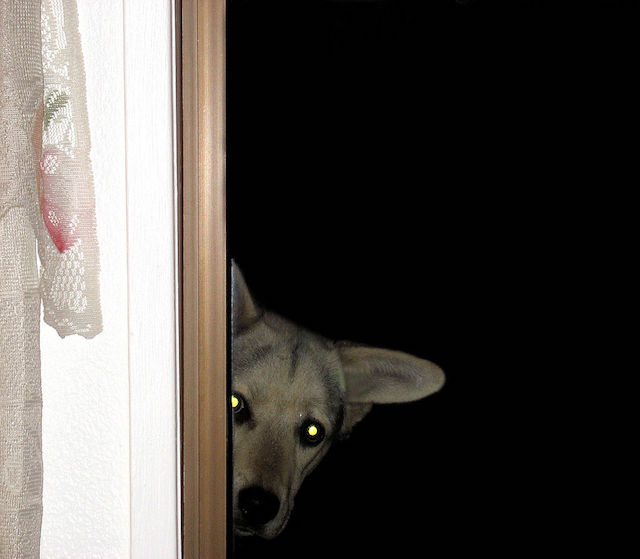

Desensitizing training involves exposing a storm-phobic dog to some gentle reminders of a thunderstorm, such as a very soft CD recording of thunder or a flashing light. If the dog does not evince any anxiety, then he/she is rewarded with treats, attention, and other positive reinforcement.
Over time, the intensity of the stimulus is increased, and only calm behavior rewarded. This needs to be done in a careful and methodical way, as you do not want to make the phobia worse.
If systematic desensitization does not work, then you may need to consult a veterinarian and see if there is a medical options available.
6. Take some simple safety precautions before and during a storm.
Identification tags. Make sure your dog is microchipped (and your information is current) or that he/she has identification tags if he/she happens to gets loose and runs away.
Bring your dog indoors. Before a storm starts, or before a fireworks display (on holidays such as the Fourth of July or Halloween), bring and keep your dog inside. Shelters say that most dogs that they take in have been left in yards during fireworks. The dogs either dig their way under fences or jump over them to escape the noise.
Be cautious opening doors. If people in your home are going inside and out, take the precaution of having your dog under control (on a leash) to prevent him/her from bolting away unexpectedly. More often than not, this is how dogs get loose and escape during storms and fireworks.
Medical and Medicinal Options
Dogs with severe symptoms may benefit from drug therapy or naturopathic therapy.
Anti-anxiety drugs. If training does not work on calming your dog, prescriptions to anti-anxiety or antidepressant medications may help calm your dog during storms. Always consult with a registered veterinarian to determine if drugs may be a suitable option for your dog.
Herbal remedies. There are a few natural herbal solutions shown to calm dogs. Bach flower extracts (such as Rescue Remedy, lavender oil (in a diffuser is best), and/or Dog Appeasing Pheromone (marketed as D.A.P. in a diffuser, spray or collar) can help calm a stressed dog.
Thundershirts. Thundershirts are a type of swaddling vest that has had success with helping dogs with anxiety. The vest is attached and worn during a storm. It has had positive results in calming anxious dogs.
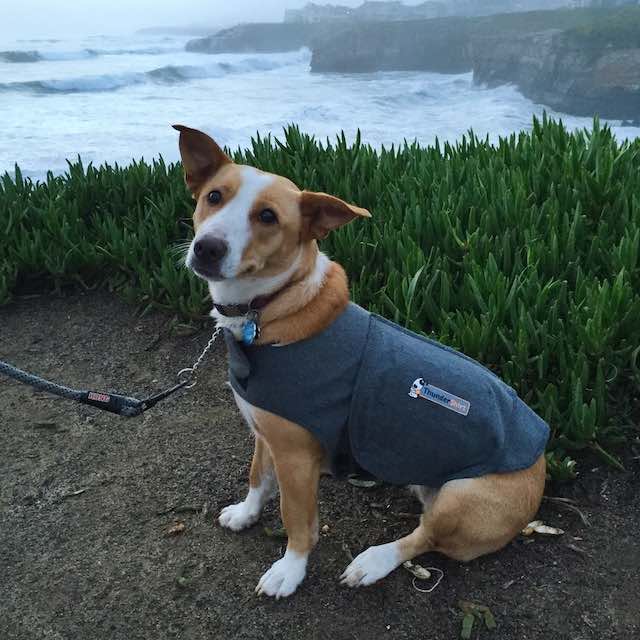

You can try using any snug dog shirt, sweater or jacket to see if it helps as well. Remove the garment if your dog show any signs of overheating or becoming more stressed with it on.
If none of these suggestions work and if your dog continues to suffer from anxiety during noisy events, you may need to see a board-certified veterinary behaviorist. Consult with your veterinarian to find a qualified specialist in your area.
It’s important to realize there is no “quick fix” solution to fixing storm phobia in dogs. Patience and perseverance and a good desensitization program will lead to positive results over time.

